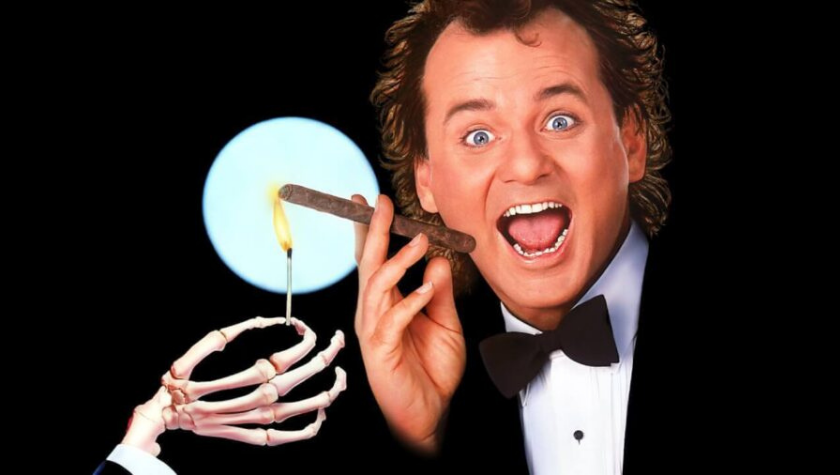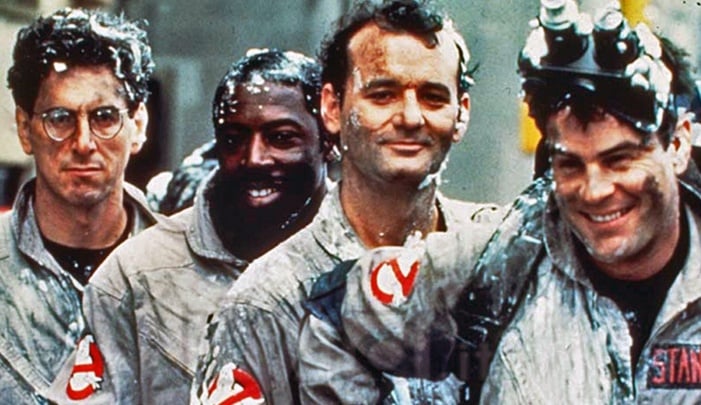How a "Bill Murray" Type Character Can Inspire Your Writing
April 8, 2016
Call him a lovable scoundrel or a dry wisecracker, Bill Murray has cultivated a very specific persona over the years. From his early days as Chevy Chase’s replacement on Saturday Night Live to his recent Netflix holiday special, A Very Murray Christmas, Murray has always stuck to his comedic guns.
He’s so synonymous with sardonic humor, I’ve read spec scripts in which a character is described as a “Bill Murray Type”. In one case, this description was used for a female character half Murray’s age!How has Murray transcended the parts that he's played?
How has he become a modern archetype?
One thing that’s notable of the “Bill Murray Type” is it’s the polar opposite of “The Everyman” archetype. Bill Murray never played an everyman.
Let’s look at a quintessential example in the beloved comedy Ghostbusters. Bill Murray’s Peter Venkman is introduced giving two college students a test to see if they have psychic abilities. Venkman holds up a card, the back of the card to the students, and he asks them if they can see what shapes are on each card (circle, triangle, etc.). In addition, the students are hooked up to a device that gives them electric shocks when they answer wrong. One student is male. The other is an attractive woman. Whenever the guy answers wrong, Venkman shocks him; whenever the girl answers wrong, Venkman pretends she answered correctly and commends her physic ability. An obvious enough gag until the guy finally answers correctly (it’s a “bunch of squiggly lines”), and Venkman knows he answered correctly.
What does Venkman do?
He still shocks him!
Not a particularly nice thing to do. The guy isn’t shown to be a jerk either. He’s just a typical college boy. It’s merely a sadistic little joke. But it’s an effective sadistic little joke. It tells us everything we need to know about Peter Venkman. He plays by his own rules and moral code. He’s not a nice guy, but he’s a gas. It can be argued that Peter Venkman never becomes a nice guy. Not in the first Ghostbusters. He’s helping out Dana Barrett, but only because he’s attracted to her. Venkman isn’t taking the high road. He’s interested in money, fame, and women. Perhaps the nicest thing he does in the film is give Ray a candy bar, and even that’s more of a snarky joke. Yet Venkman is arguably the most popular character in the film, and a major part of its enduring appeal.
Why is this?
Because he’s witty, charming, fun and interesting!
Murray would play this type of character for years, peaking with his tour de force: 1993‘s Groundhog Day.
I can’t think of a better example of "right character/right story" than Groundhog Day. It's also one of the greatest comedy screenplays ever written. From a purely compositional viewpoint, it’s a machine. It hits every comedic and dramatic beat with such confident stride, the writers, Harold Ramis and Danny Rubin, had to know they were writing a comedy classic. That being said, Bill Murray adds immeasurably to an already fantastic story. His character, Phil Connors, is a culmination of every character Murray had been playing up to that point. Taking a cue from Scrooged, which Murray had done a few years prior, Groundhog Day is built around a powerful redemptive arc. A redemptive arc is the progression a character goes through from being considerably flawed to being considerably less flawed. Or to put it simply, it’s when a jerk becomes a nice person. As such, the bigger the jerk, the more compelling the arc.
At the start of the film, Phil Connors is such a cold, narcissistic, cynical guy, even Peter Venkman would dislike him. And there isn’t the slightest attempt to soften the character. He browbeats and insults everyone around him. His opinion of humanity can be summed up in one brilliantly acerbic line: “People like blood sausage. People are morons.” He’s a Pittsburg weatherman who thinks of himself as a major talent and is considered a “prima donna” by his colleagues. Not an everyman by any means. In most films, he’d be the villain. Typically, the more a character redeems himself at the end, the more you can get away with at the beginning. And perhaps it’s due to the degree of the redemption in Groundhog Day (Phil becomes the greatest guy, like ever, at the end), that it can feature such a nasty protagonist.
Many people would ask: “Why are we invested in such an unpleasant character as Phil Connors? Why do we care if he redeems himself and learns to become a decent human being?” He’s even lacking Murray’s previous class clown charm. He’s just a mean guy. But he is clever and he is witty. And most importantly, he’s interesting. You want to know more about this guy. He dares to be so mean-spirited, when we all have to be so agreeable. The character hooks you in before the film’s gimmick manifests. You’re prepared to take this journey with Phil, not because you think, deep down, he’s an all right guy. You’re prepared to take it because you know it won’t be boring.
And it’s a darn good gimmick.
But Groundhog Day never allows the gimmick to overshadow the protagonist. It’s a character-driven film from start to finish. If anything, the gimmick allows for more Murray than we’ve ever been treated to before, or after. No summer camp. No boot camp. No ghosts. No Max Fischer. It’s just Murray reliving the same day again and again and again. And even though the gimmick is quite fantastic (and mercifully unexplained), it’s grounded in a reality that gives it weight. For example, when Phil Connors first discovers he’s reliving the same day, his reaction is to freak out. In a hilariously prima donna move, he tries to get his producer, Rita (played by Andie MacDowell), to do something about it even though the phenomenon clearly falls outside her job responsibilities. Rita, so earnest and straight-laced, is the needed foil or straight character for Phil to bounce off. She also becomes the love interest as the film nimbly shifts gears in the second act.
A term that will pop up for many writers dealing with a redemptive arc is “earn”. Does the character earn their love interest by the end? Do they earn the happy ending? Phil definitely earns Rita and his happy ending. Instead of rushing the transition, Groundhog Day allows Phil to discover empathy in a slow and organic way. It never feels forced, and he doesn’t come across as Dudley Do-Right at the end of the film either (even though he’s doing right by many people). He’s still making his quips, but now he’s using his wit to connect with others rather than push them away.
It’s not a story about conforming.
It’s a story about becoming the best, most awesome person you can become. It’s about embracing life.
Now picture Groundhog Day with a nice, everyman character.
Would it be as funny? Would it pull us in from the start? Would the character’s journey be as compelling?
If you ever have trouble coming up with a great protagonist for a comedy, think of Bill Murray, and the archetypes he has created throughout the years.
It should offer much inspiration.
Written by: Edwin Cannistraci
Edwin Cannistraci is a professional screenwriter. His comedy specs PIERRE PIERRE and O’GUNN both sold with more than one A-list actor and director attached. In addition, he’s successfully pitched feature scripts, TV pilots and has landed various assignment jobs for Universal, Warner Bros, Paramount and Disney.- Topics:
- Screenwriting & Craft




